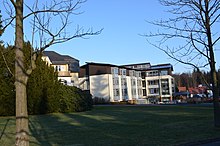Hohe Mark Clinic
| Hohe Mark Clinic | |
|---|---|
| Sponsorship | Hospital GmbH of the German Community Diakonieverband |
| place | Oberursel |
| state | Hesse |
| Country | Germany |
| Coordinates | 50 ° 12 '42 " N , 8 ° 31' 52" E |
| areas of expertise | Psychiatry and psychotherapy |
| founding | 1904 |
| Website | Klinik-hohe-mark.com |
The Hohe Mark Clinic is a specialist hospital for psychiatry , psychotherapy and psychosomatics with locations in Oberursel (Taunus) and Frankfurt am Main in Hesse . The aim of the clinic is to provide professionally competent and committed Christian help for people with mental disorders including addictions.
The clinic is run by the Krankenhaus GmbH of the German Diaconal Association , which includes the Hohe Mark Clinic and other hospitals and medical facilities.
Emergence
At the beginning of the 20th century, the neurologist from Austria, Adolf A. Friedländer, planned to build a private neurologist clinic for the German and foreign aristocrats. The clinic was built between 1902 and 1904 on a forest meadow near Bad Homburg vor der Höhe , on the southern slope of the Taunus, and opened on March 1, 1904 under the name of the Hohe Mark im Taunus private clinic .
In the founding year 1904, a total of 52 patients were treated. The number of patients increased continuously until the beginning of the First World War . Many noble and stately people from Germany , England , Sweden , Holland and the United States were treated in the clinic. Among other things, Empress Auguste Viktoria visited sick relatives in 1910. On the grounds of the clinic, aristocratic and wealthy patients and their servants were able to occupy villas . The most prominent patient of this time was Prince Heinrich of the Netherlands .
After the First World War, the economic situation changed considerably, as the nobility no longer had the financial means at their disposal. Friedländer sold the property to the city of Frankfurt after his return from the war in 1918 . This continued the clinic for civil servants from the middle class. Due to the global economic crisis , the clinic had to be closed for financial reasons.
In 1930 the clinic was offered for sale to the German Community Diakonieverband (DGD). The negotiations initially failed because of the price demands.
time of the nationalsocialism
It was not until July 23, 1933 that the DGD acquired the Hohe Mark sanatorium, which had been vacant for three years . With the help of deaconesses and Bible students of the DGD, the neglected buildings were renovated and finally reopened on October 21, 1933 under the name of Kuranstalt Hohe Mark for nervous and mental ailments .
On August 26, 1939, the Hohe Mark sanatorium was converted into a reserve hospital by order of the Wehrmacht . The new regulation prevented the facility from being included in the T4 killing program for mentally ill people that was later launched by the National Socialists . In addition to the German soldiers, the field hospital also looked after foreign airmen who had been shot down during operations over Germany and who were interned in the nearby prisoner of war camp ( Dulag Luft ) after they had been healed .
post war period
After the liberation by US soldiers, the clinic remained a hospital until 1946. In addition, up to 400 patients were treated in the sanatorium. The good relationship between the management of the institution and the allies who supported the facility played an essential role. The reason was the good treatment of foreign airmen during the war. On August 17, 1948, the sanatorium received the recognition as a specialist institute from the district president, which it had already been awarded in 1935. In 1969 the Hohe Mark sanatorium was renamed the Hohe Mark Clinic . Since 1999 the clinic has been entrusted with taking over the psychiatric regional care of the east of Frankfurt.
Haus Herzberg opened in 2013. The second construction phase was opened in spring 2017. It has six wards with 144 beds. The construction costs amounted to 8.3 million euros.
In April 2020, the clinic cleared two stations in order to counteract congestion in hospitals during the Covid-19 pandemic. A total of 46 beds were kept free to accommodate people in need of care. Due to the measures in Germany, the number of infections remained below 1.5% and the first of the two stations resumed normal operations two months later.
Facility
The clinic has 234 beds in Oberursel and 20 day clinic places in Frankfurt am Main.
Web links
Individual evidence
- ^ Mission statement of the Hohe Mark Clinic ( memento of July 10, 2010 in the Internet Archive ), accessed on March 18, 2010
- ↑ On the art of working together. Retrieved June 9, 2020 . (PDF file; 1.88 MB), at hohemark.de
- ↑ a b Klinik Hohe Mark - Chronicle at a Glance. Retrieved June 9, 2020 . , on hohemark.de
- ↑ Klinik Hohe Mark: Haus Feldberg is ready! , on hohemark.de
- ↑ Notice of Corona Hohe Mark
- ↑ Hessen Ministry of Health Corona cases
- ↑ History , on hohemark.de




